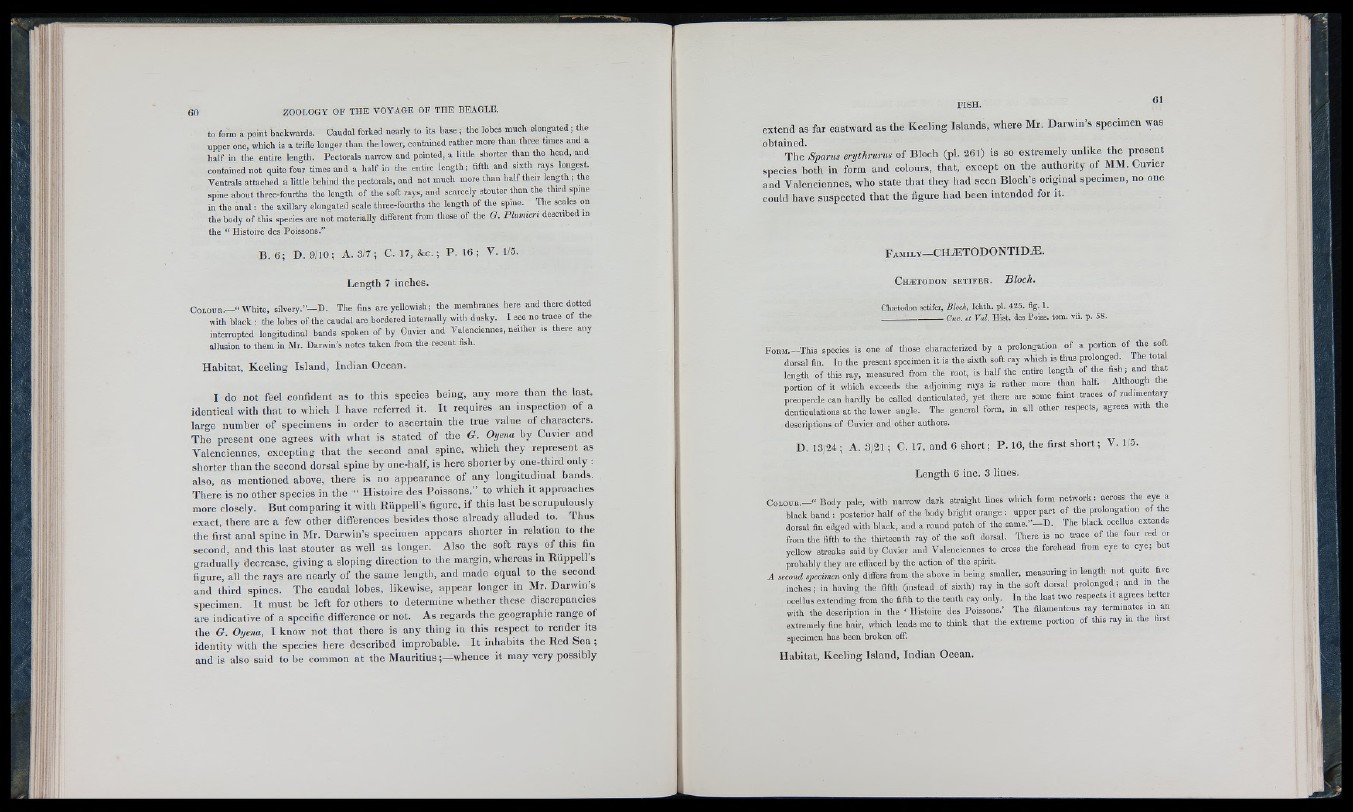
to form a point backwards. Caudal forked nearly to its base ; the lobes much elongated ; the
upper one, which is a trifle longer than the lower, contained rather more than three times and a
h alf in the entire length. Pectorals narrow and pointed, a little shorter than the head, and
eontained not quite four times and a h alf in the entire len g th ; fifth and sixth rays longest.
Ventrals attached a little behind the pectorals, and not much more than half their length ; the
spine about three-fourths the length of the soft rays, and scarcely stouter ffian the third spine
in the a n a l: the axillary elongated scale three-fourths the length of the spine. ^ The scales on
the body of this species are not materially different from those of the G . P lum ten described m
the “ Histoire des Poissons.”
B. 0; D. 9/10; A. 3/7 ; C. 17, &c.; P . 16 ; V. 1/5.
Length 7 inches.
C O L O U E .-“ W hite, s ilv e ry ," -D . The fins are yellowish; the membranes here and there dotted
with black : the lobes of the caudal are bordered internally with dusky. I see no trace ot the
interrupted longitudinal bands spoken of b , Cuvier and Valenciennes, neither is there any
allusion to them in Mr. Darw in's notes taken from the recent fish.
H abitat, Keeling Island, Indian Ocean.
I do not feel confident as to this species being, any more than the last,
identical with that to which I have referred it. It requires an inspection of a
large number of specimens in order to ascertain the true value of characters.
The present one agrees with what is stated of the G. Oyena by Cuvier and
Valenciennes, excepting that the second anal spine, which they represent as
shorter than tlie second dorsal spine by one-Iialf, is here sliorter by oneftliivd only :
also, as mentioned above, there is no appearance of any longitudinal hands.
There is no other species in the “ Histoire des Poissons,” to which it approaches
more closely. B ut comparing it with Ruppell’s figure, if this last be scrupulously
exact, there are a few other differences besides those already alluded to. Thus
the first anal spine in Mr. Darwin’s specimen appears shorter m relation to tile
second, and this last stouter as well as longer. Also the soft rays of this fin
gradually decrease, giving a sloping direction to the m a r g i n , whereas in R uppell’s
figure, all the rays are nearly of the same length, and made equal to the second
and third spines. The caudal lobes, likewise, appear longer in Mr. Darwin’s
specimen. It must be left for otliers to determine whether these discrepancies
are indicative of a specific difference or not. As regards the geographic range of
tlie G. Oyena, I know not tliat there is any thing in this respect to render its
identity with the species here described improbable. It inliahits the Red Sea ;
and is also said to be common at the Mauritius ¡—whence it may very possibly
extend as far eastward as the Keeling Islands, where Mr. Darwin’s specimen was
obtaiTnleide. Spams erythrarus of Bloch (pi. 261) is so extremely unli,k e th. e present
species both in form and colours, that, except on the authority of MM. Cuvier
and Valenciennes, who .state that they had seen Bloch’s original specimen, no one
could liave suspected that the figure had been intended for it.
F a m il y — C H ® T O D O N T ID ® .
C h / e t o d o n s e t i f e r . B h c li .
Chastodon setifer, Blech, Ichth, pi. A25. fig. 1.
_______________ Cue. et Val. Hist, des Poiss. tom. vii. p. 58.
F o ilM .-T his species is one of those characterised by a prolongation of a portion »f
dorsal fin. In the present specimen it is the sixth soft ray winch is thus prolonged The tota
length of this ray, measured from the root, is h alf the entire length of the fish ; and that
portion of it which exceeds the adjoining rays is rather more than half. Although the
preopercle can hardly be called denticulated, yet there are some fam t traces of rudimentary
denticulations a t the lower angle. The general form, in all other respects, agrees with the
descriptions of Cuvier and other authors.
D. 13/24 ; A. 3/21 ; C. 17, and 6 short; P . 16, the first sh ort; V. 1;5,
Length 6 inc. 3 lines.
C o l o u r .— “ Body pale, with narrow dark straight lines which form n etw ork ; across the eye a
black band ; posterior h alf of the body bright orange : upper p art of the prolongation of the
dorsal fln edged with black, and a round patch of the same.”— D. The black ooellus extends
from the fifth to the thirteenth ray of the soft dorsal. There is no trace of the four red or
yellow streaks said by Cuvier and Valenciennes to cross the forehead from eye to eye; but
probably they are effaced by the action of the spirit.
A second specimen only differs from the above m being smaller, measuring in length not quite h .e
inches; in having the fifth (instead of sixth) ray in the soft dorsal prolonged; and m the
ocellus extending from the fifth to the tenth ray only. In the last two respects it agrees better
with the description in the ‘ Histoire des Poissons.’ The filamentous ray termmates m an
extremely fine hair, which leads me to think that the extreme portion of this ray in the first
specimen has been broken off.
Habitat, Keeling Island, Indian Ocean.